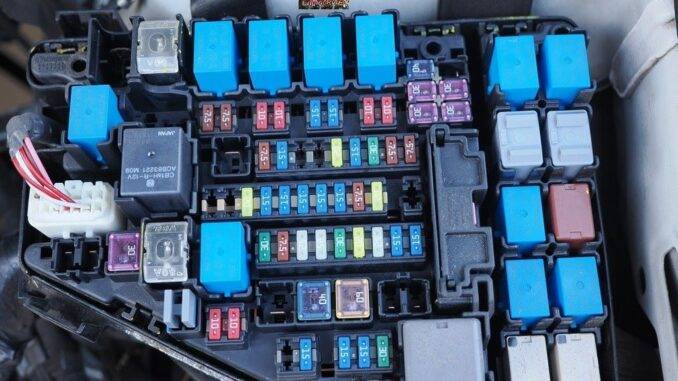
Automotive fuses, protect the circuits in your vehicle, from excessive current flow.
So, if an electrical item in your vehicle stops working, the first thing to do is, check the automotive fuses.
Engineers size automotive fuses, for about twice the normal current draw. For instance, if a device normally draws 10 amps, a fuse of roughly 20 amps in size might protect it.
Automotive fuses blow at an amperage, below the point, where damage occurs in the circuit.
Therefore, the fuse burns out at 20 amps, which is below the current, that might damage the circuit. So, the most common car fuses, are blade fuses. And, are identified by the color of the fuse, and a number marked on the exposed face.
Unfortunately, over time electrical systems and components can develop issues, that cause car fuses to blow.
Locating The Automotive Fuses Panel
Your owner’s manual will tell you, where your vehicle’s fuse panel is. Most models situate the fuse panel, on the driver’s side of the dashboard. And, usually under the steering wheel or in the engine compartment. But, locations may vary, from vehicle to vehicle.
Loss Of Power To Accessories
So, one of the first symptoms of an issue with a fuse, is loss of power. And, will affect one or more of the vehicle’s, functions or accessories. Fuses are installed in line of specific circuits. Consequently, in order to protect those circuits from, potentially overloading. So, if those circuits do become overloaded, for any reason. Then, the fuse will blow and cut off power to the circuit.
Some of the biggest issues are, loss of power to electric fuel pumps. This will stop your vehicle from starting. And, an even worse problem would be, loss of power to the electric engine cooling fan. Because, if the engine overheats, major damage is possible.
Consequently, protecting it from possible damage. So, if you notice that any of the vehicle’s functions or accessories, stop working. Such as, the radio, wipers, power windows or locks, it may be related to blown automotive fuses. This is where troubleshooting your electrical system can solve many problems.
You cannot always tell if a fuse is good, by just looking at it. Consequently, a blown fuse may actually look good. That’s why, testing the fuse with a multimeter tool is recommended, in order to be sure.
Testing A Fuse, Without Removing It
Pulling a fuse out of the fuse box to check it, has many disadvantages. Electrically testing the fuse, will show if it is bad or good. Another problem with pulling fuses is “keep alive” power for the various modules on the vehicle may be lost.
This could result in poor idling, a loss of diagnostic information and sometimes accessories that, do not work.
The terminals in a fuse box are fragile, and you may damage them when trying to remove them. This may cause a loose connection and a future problem. So, using a multimeter to check fuses will be faster, and will avoid these problems.
If you don’t want to break electrical continuity, to components a fuse handles. Then, a fuse can be checked, while still in place using a multimeter. Remember the car’s metal frame, is one side of its electrical circuit.
First, set the meter’s “Function” switch to “DC Volts”. Then, set the “Range” switch. To a scale that will allow you to read 12 volts or the next level up.
Testing, Blade Type Automotive Fuses
Turn the ignition switch to the run position. Locate the small holes, on each end of the blade type fuses. Those holes give you access, to the blades inside the fuse. Insert the pointed tip of the red test lead, first in one hole and then in the other.
Test Results:
- So, a reading of 12 volts to ground on one end, but not the other. Tells you the fuse is blown.
- You should see a voltage reading, in the 12-14 volts range.
- Readings on both sides of the fuse, indicate it is working properly.
If the fuse is good, but the device controlled by the fuse does not function. Then, there is a problem, somewhere downstream of the automotive fuses.
If neither side yields a reading, there is no current flowing into the fuse to begin with. Therefore, indicating an electrical problem, upstream of where the fuse is.
Other Ways Of Testing Fuses:
- Visual inspection
- Fuse tester
- Test light
Conclusion
So, fuses blow from time to time, and there’s no need for concern, if the problem does not reoccur. You just have to buy another fuse that is the same, and plug it in. Finally, always start with checking the automotive fuses first. Because, it might just be that simple.
BY DANNY BENDER


